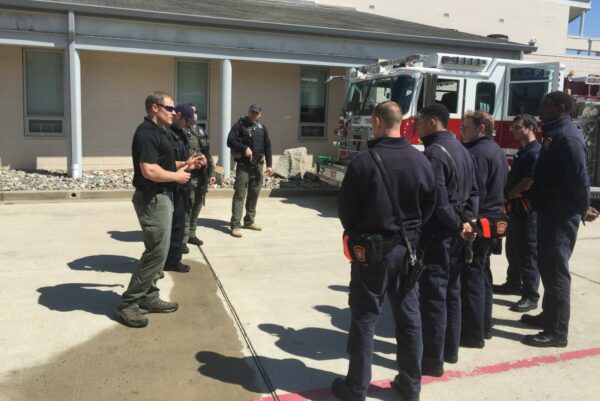
Over 13 years ago, Arlington’s fire and police departments first teamed up to better address active shooter situations.
Since then, their partnership — called the Rescue Task Force — has become the standard for when police and fire personnel respond together to high-threat situations, according to The National Fire Protection Association. The departments’ model was even adopted for the 2012 London Olympics.
In recent years, the task force has taken on a new threat requiring teamwork between police and fire: explosives.
The expanding role of the task force reflects how the fire department’s responsibilities have evolved over the last decade, as well as an increased need for intra-agency cooperation to handle complex situations. As public safety threats have changed, so too have the duties of firefighters. Gone are the days when they just fought fires — now, they save lives in active shooter situations and defuse bombs.
“I would love to be able to go back in time and ride on the tailboard and just put out fires but that’s not the world we live in,” said Arlington County Fire Department Captain John Delaney, on an episode of the Fire Engineering Podcast. “This is a new world order and there’s new expectations placed on the fire service and we and our leaders have to rise up and meet those expectations.”
The idea for the Rescue Task Force originated in 2007, when ACFD was training for a school-shooter scenario at Marymount University, said Delaney.
Under the protocol at the time, the fire department had to wait until police located the shooter to enter the building and tend to victims. The department’s medical director, Dr. Reed Smith, and a few colleagues raised concerns that — if this had been a real school shooting — the people shot would have died by the time the fire department arrived.
In response, the fire department reimagined its approach to high threat situations, the captain said. Now, police identify “warm zones,” or areas the shooter has visited and since left — firefighters are dispatched to these zones to tend to victims while police continue searching for the shooter.
After some convincing, firefighters got on board, and the Rescue Task Force was born, said Delaney. The first responders’ gear now includes bulletproof vests and tourniquets, reflecting this new role in active-shooter situations.
“We’d always had a conservative, reserved approach and that has changed since we accepted this higher level of risk,” Delaney said. “We know we’ll save lives.”
Over the past three to four years, the task force’s attention has shifted to explosive threats, too. Originally, the response was somewhat fragmented: either a bomb technician from the fire department or an officer from the police department would assess the threat, said ACFD spokesman Lt. Nate Hiner.
Now, the departments work together: an ACPD explosives K-9, a trained handler, and an ACFD bomb technician examine the threat together, and if the trio determines it’s unsafe, the fire department’s bomb squad deals with the object, Hiner said.
Delaney said the next focus area for the task force could be refining its response to fires not as just fires, but as weapons. Intentionally-set fires are becoming a more common threat, he said.
According to Hiner, the benefits of the police-fire partnership extend beyond high threat situations.
“In preparing for these events, it’s boosted our ability to respond to everyday events in integrated ways,” he said.
Delaney said the task force has become an essential part of the work both departments do. He encouraged other fire and police departments to prepare for high threat situations together.
“Any chief in any fire department that doesn’t think that [a high threat situation] is a possibility within their jurisdiction is effing kidding themselves,” Delaney said on the podcast.

